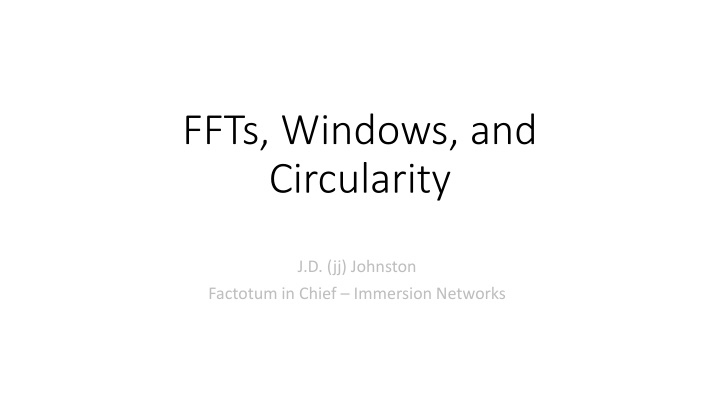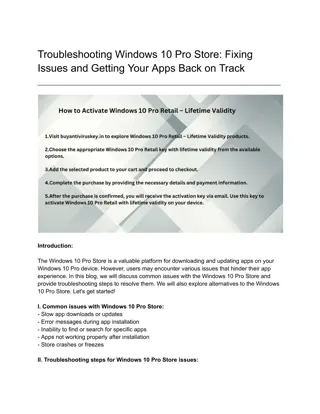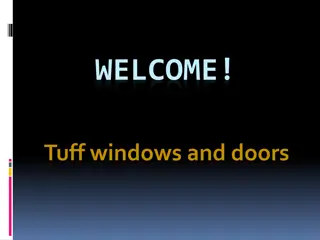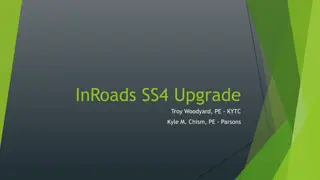Urgent Action Required: Upgrade Windows Systems Now
Ensure data security and prevent system vulnerabilities by upgrading Windows systems before Microsoft ends support in January 2020. Take advantage of great prices for Dell computers and free upgrade services provided by ITS. Contact Lisa Aitken for assistance.
Download Presentation

Please find below an Image/Link to download the presentation.
The content on the website is provided AS IS for your information and personal use only. It may not be sold, licensed, or shared on other websites without obtaining consent from the author.If you encounter any issues during the download, it is possible that the publisher has removed the file from their server.
You are allowed to download the files provided on this website for personal or commercial use, subject to the condition that they are used lawfully. All files are the property of their respective owners.
The content on the website is provided AS IS for your information and personal use only. It may not be sold, licensed, or shared on other websites without obtaining consent from the author.
E N D
Presentation Transcript
FFTs, Windows, and Circularity J.D. (jj) Johnston Factotum in Chief Immersion Networks
First, two properties of the FFT Circularity Signal discontinuities
First, lets review a very important property of the FFT, that being circularity. When you apply an FFT, it assumes that the last sample in the FFT comes just before the first sample, in other words, the ends wrap around. This causes a number of issues, including the need for windowing. But first, let s show an example.
Signal Amplitude Spectrum Signal (shifted) Amplitude Spectrum
Wait, what??? The signal was shifted. This means: The only difference is in phase I didn t plot the phase The delay was 16 samples, which works out to phi = t * w, where t is the delay Yeah. That simple. The signal WRAPS AROUND!!!! And thence we need windows.
Now: Discontinuities in Fourier Transforms The kind of discontinuity in a signal defines how fast the spectrum falls off. If there is a discontinuity in the signal, but only one (not a doublet) the spectrum falls off at 6dB/octave. If there is a discontinuity in the derivative, 12dB/octave If there is a doublet in the signal, the signal has a strong flat component And so on. But what does this have to do with a window?
Time Waveform Square Wave (1st derivative) Blue Triangular Wave (2nd Derivative Red) Corresponding amplitude Spectra
Back to the FFT and the Window What happens when the end and the beginning of a window do not match up
Ok, FFT of 2 slightly different frequency sine waves Remember, a sine wave has a ***LINE*** spectrum, right? What if it s not an integer number of cycles in the FFT length? Oh, wait, then there s a discontinuity. It won t blend end to beginning. Yep. That s why we window!
Two sine waves Resulting spectra
That discontinuity! The discontinuity at the end (which is the same as any other point, since the FFT wraps around) causes a massive mis-estimation of the signal spectrum. This, in a nutshell, is why you must window. Otherwise, signals at different frequencies are treated ***DIFFERENTLY*** and block lengths of FFT s (or DFT s) will confound the daylights out of what you are looking at. Yes, the FFT is still lossless, phase included. But generally in this particular analysis, we re looking for the signal spectrum, and we re not doing such a good estimation!
Windows There are many windows. Rectangular (that s what you get when you don t window, since you really ARE windowing, but with a signal that s just chopped off at both ends. Triangular (zero at both ends, but not zero derivative) Hann window (zero at both ends, first derivative also zero at both ends) Windows handle the issue of discontinuity at the beginning and end of the block.
This brings us to another issue, time/frequency uncertainty Your frequency estimation is only as good as your time window. df * dt >= c df is frequency resolution dt is time resolution c is determined by how good you want the estimation to be All windows except for rectangular shorten the time duration of the signal, as they are smaller at the ends. Windows therefore reduce the frequency precision, but treat all frequencies the same. (in general, there are specialty windows beyond rectangular)
Some windows in common use: Window Spectrum of Window First lines of window spectrum Hann vs. Triangular (black vs. blue)
What do we see? Triangular window is zero at the ends Triangular window is ***NOT*** zero derivative at the ends Hann window is zero and also in first derivative And it rolls off faster, a lot faster. The increase in frequency resolution isn t much worth it, either.
And another pair of windows: First few lines of spectrum Window Spectrum of Window This is Hann (black) vs. Blackman (blue)
So, always use a Hann window? There are some operations, usually involving system measurements, where a window is only marginally necessary, because the signals are limited in time However, noise can create problems by adding a discontinuity into this measurement Adding a window can create ambiguities in measurement There is no magical answer, understand what you measure.
But, WAIT, you just showed the frequency response of the window. What about the signal? The signal simply modulates the window. For a sine wave signal, it moves the peak away from DC to some other frequency For a complex signal, it convolves the spectrum of the signal with the spectrum of the window. That goes back to the convolution theorem discussed briefly in the FFT Workshop some years ago. This makes the point that a window is nothing but a particular kind of low-pass filter, of course.
An example of a sine wave, windowed. Sine wave Window Windowed Sine Wave Resulting spectrum Note peak shifted to sine wave frequency.
Finally, some different windows characterized Peak shape Full Spectra Window Black Hann, Red Blackman, Green Kaiser (5), Blue -Nuttall























